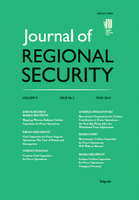Foreword: Civilian Involvement in Peacekeeping Operations in the Western Balkans
Abstract
Peacekeeping has come a long way since the basic principles which define it were laid down by Lester Pearson and Dag Hammarskjold, to guide the deployment of the first full UN mission, UNEF I, in 1956. Since 1956, it has been generally accepted that peacekeeping is a function of the UN, but there are occasions when it has been used by international and regional organisations other than the UN, and there are operations which can be seen as early uses of peacekeeping which predated the formation of the UN in 1945. After the First World War, for example, multinational military bodies were used to establish and administer the new frontiers of Europe agreed by peace treaties after the war. Also after the First World War the League of Nations conducted activities which were comparable in some respects to peacekeeping. However, since 1945 peacekeeping has been the technique most frequently used by and associated with the United Nations to terminate conflicts and establish peace, so much so that the organisation was awarded the Nobel Peace Prize for its peacekeeping activities in 1988 and indeed Pearson and Hammarskjold, the two people who ‘invented’ peacekeeping as a so-called chapter six and a half activity of the UN were also awarded the Nobel Peace Prize in 1957.
Authors retain copyright of the published papers and grant to the publisher the non-exclusive right to publish the article, to be cited as its original publisher in case of reuse, and to distribute it in all forms and media.
The published articles will be distributed under the Creative Commons Attribution 4.0 International License (CC BY). It is allowed to copy and redistribute the material in any medium or format, and remix, transform, and build upon it for any purpose, even commercially, as long as appropriate credit is given to the original author(s), a link to the license is provided and it is indicated if changes were made. / The published articles will be distributed under the Creative Commons Attribution ShareAlike 4.0 International license (CC BY-SA). It is allowed to copy and redistribute the material in any medium or format, and remix, transform, and build upon it for any purpose, even commercially, as long as appropriate credit is given to the original author(s), a link to the license is provided, it is indicated if changes were made and the new work is distributed under the same license as the original.
Users are required to provide full bibliographic description of the original publication (authors, article title, journal title, volume, issue, pages), as well as its DOI code. In electronic publishing, users are also required to link the content with both the original article published in Journal of Regional Security and the licence used.
Authors are able to enter into separate, additional contractual arrangements for the non-exclusive distribution of the journal's published version of the work (e.g., post it to an institutional repository or publish it in a book), with an acknowledgement of its initial publication in this journal.
Authors are permitted to deposit author’s pre-print / author’s post-print (accepted version) / publisher's version (PDF) of their work in an institutional repository, subject-based repository, author's personal website (including social networking sites, such as ResearchGate, Academia.edu, etc.), and/or departmental website prior or during the submission process / at any time after the acceptance of the manuscript / at any time after publication.
Full bibliographic information (authors, article title, journal title, volume, issue, pages) about the original publication must be provided and links must be made to the article's DOI and the license.

